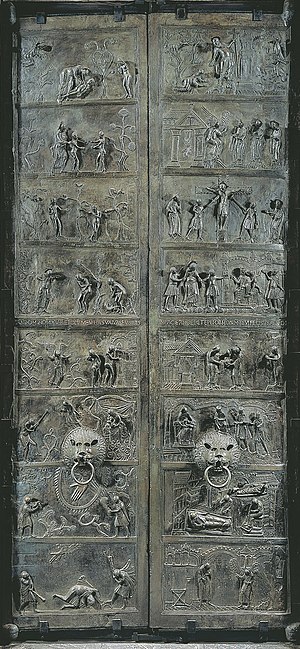Bernward Doors
| Bernward Doors | |
|---|---|

The image side of the bronze doors of the Hildesheim Cathedral, showing scenes from the Book of Genesis on the left leaf, from top to bottom, and from the life of Jesus on the right leaf, from bottom to top
|
|
| Year | c. 1015 |
| Type | Ottonian art |
| Medium | Bronze |
| Location | Hildesheim, Germany |
| 52°08′56″N 9°56′47″E / 52.1489°N 9.9464°ECoordinates: 52°08′56″N 9°56′47″E / 52.1489°N 9.9464°E | |
The Bernward Doors (German: Bernwardstür) are the two leaves of a pair of Ottonian or Romanesque bronze doors, made c. 1015 for Hildesheim Cathedral in Germany. They were commissioned by Bishop Bernward of Hildesheim (938–1022). The doors show relief images from the Bible, scenes from the Book of Genesis on the left door and from the life of Jesus on the right door. They are considered a masterpiece of Ottonian art, and feature the oldest known monumental image cycle in German sculpture, and also the oldest cycle of images cast in metal in Germany.
Along with the Bernward Column, the doors are part of Bishop Bernward's efforts to create a cultural ascendancy for the seat of his diocese with artistic masterpieces in the context of the Renovatio imperii sought by the Ottonians. A Latin inscription on the middle crossbar produced after Bernward's death gives the year 1015 as the terminus ante quem for the creation of the doors:
AN[NO] DOM[INI] INC[ARNATIONIS] M XV B[ERNVARDVS] EP[ISCOPVS] DIVE MEM[ORIE] HAS VALVAS FVSILES IN FACIE[M] ANGELICI TE[M]PLI OB MONIM[EN]T[VM] SVI FEC[IT] SVSPENDI
(In the 1015th year of the incarnation of the Lord, Bishop Bernward (richly remembered) had these cast doors hung at the front of the angelic temple to his own memory)
Each leaf of the doors was cast as a single piece. Given the size (left: 472.0 x 125.0 cm, right: 472.0 x 114.5 cm, maximum thickness c. 3.5-4.5 cm) and enormous weight (both c. 1.85 tonnes) of the doors, this is a great achievement for its time. The raw material for the casting was Gunmetal, which consisted predominantly of copper (above 80%) with roughly equal parts of lead, tin, and zinc. To date material analysis has not been able to show which ore deposit the metal came from, though the ironworks at Rammelsberg near Goslar has been ruled out.
...
Wikipedia
